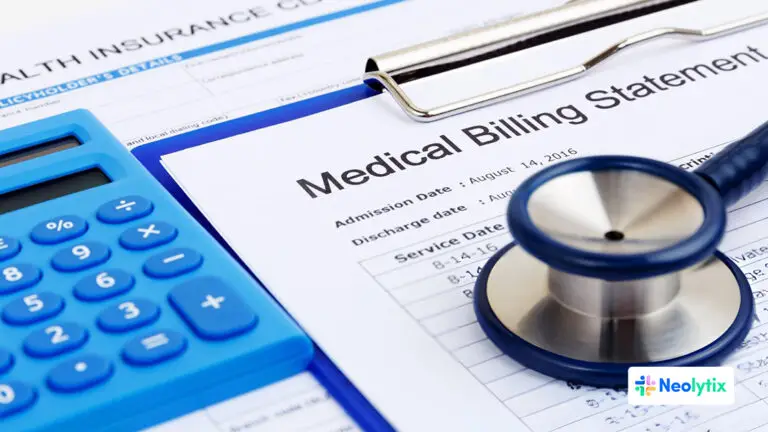Accurate and timely medical billing is crucial for healthcare organizations, ensuring they receive proper compensation for services rendered while maintaining financial stability.
The dynamic changes in the healthcare industry, driven by technological advancements, regulatory updates, and a shift towards patient-centric care, are reshaping the medical billing landscape. For decision-makers in the healthcare sector, understanding these changes is essential to optimize revenue cycles and sustain financial health amidst evolving practices.
The Role of Automation and Artificial Intelligence
Automation and AI are revolutionizing the healthcare industry, particularly in medical billing. By streamlining processes and enhancing accuracy, these technologies are setting new standards for efficiency and compliance with a great potential for future improvements.
Error Reduction
Automation dramatically cuts down on human errors, which are common in repetitive manual data entry tasks. It achieves this by:
- Consistency and Accuracy: Automated systems ensure consistent and accurate patient data entry every time.
- Validation Checks: Real-time validation checks ensure completeness and correctness before submission, reducing claim rejections.
Future advancements could include more complex machine learning algorithms that predict and correct potential errors in real-time, further minimizing human error.
Efficiency
Automation streamlines processes, ensuring faster billing cycles and improved cash flow. It does this by:
- Speed: Automating tasks that humans would take hours to complete in minutes.
- Workflow Integration: Seamlessly integrating with other systems, such as EHRs, to reduce manual data transfer.
When it comes to efficiency-related upgrades, future improvements may include intelligent workflow management systems that dynamically adjust processes based on real-time data, ensuring optimal performance and even quicker billing cycles.
These error-reduction and efficiency benefits make automation a transformative force in medical billing, leading to more reliable and efficient operations and better financial outcomes for healthcare providers.
Future Tech Trends
Imagine a healthcare system where billing errors are nearly non-existent, and processes are so efficient that financial health is guaranteed. This vision is becoming a reality with advanced AI and automation tools.
These technologies are constantly evolving to integrate seamlessly with existing healthcare systems, handling complex tasks, adapting to regulatory changes, and providing real-time updates.
- Robotic Process Automation (RPA): Tools like UiPath and Blue Prism are being used to automate repetitive tasks such as data entry, invoice processing, and compliance checks, reducing manual workloads and increasing accuracy.
- Intelligent Document Processing (IDP): Systems such as ABBYY and Kofax are employed to process and extract information from unstructured data sources like medical forms and patient records, transforming them into structured data for billing purposes.
These tools are not just improving current processes but are setting the stage for a future where automated medical billing is the standard, enhancing efficiency and accuracy across the board.
Interoperability and Electronic Health Records (EHR)
The adoption of Electronic Health Records (EHR) has transformed the healthcare industry, improving data management and patient care. EHR, especially when used with automated systems, facilitates the seamless recording, retrieval, and sharing of patient information, enhancing accuracy and revolutionizing the efficiency of medical billing.
Benefits of EHR Adoption
Adopting Electronic Health Records (EHR) brings numerous benefits to healthcare organizations, particularly in billing accuracy and operational efficiency.
Benefits of EHR Adoption
- Error Reduction: Streamlines recording and sharing patient information, minimizing errors.
- Improved Billing Accuracy: Ensures all necessary data is available for claims processing.
- Enhanced Efficiency: Facilitates seamless data exchange, reducing redundant data entry.
- Faster Claims Processing: Automates data transfer, leading to quicker processing times.
- Better Patient Outcomes: Consistent information across platforms improves overall patient care.
These benefits illustrate how EHR adoption and interoperability can transform healthcare operations, making them more efficient and reliable.
Telehealth and Remote Patient Monitoring
The COVID-19 pandemic significantly accelerated the adoption of telehealth services, allowing patients to receive medical care remotely. This surge has highlighted the need for adjustments in billing processes to accommodate virtual consultations and remote patient monitoring.
Billing Adjustments for Telehealth
Adapting to telehealth requires the introduction of new billing codes and reimbursement structures tailored to virtual healthcare services. This includes codes for teleconsultations, remote diagnostics, and continuous patient monitoring, ensuring that providers are compensated fairly for digital health services.
New Billing Codes and Devices
Examples of new billing codes include those introduced by the Centers for Medicare & Medicaid Services (CMS) for telehealth services. Additionally, the advent of advanced remote monitoring devices, such as wearable health trackers and mobile health apps, necessitates further updates to billing practices to cover these innovative healthcare services.
Value-Based Reimbursement Models
Traditional vs. Value-Based Reimbursement
While the old model reimbursed providers based on the quantity of services, often leading to inefficiencies and higher costs, value-based care models focus on quality and outcomes. This approach incentivizes healthcare providers to deliver high-quality, cost-effective care, rewarding them for keeping patients healthy rather than simply treating them frequently.
Emphasis on Quality and Outcomes
Value-based care emphasizes improved patient outcomes and cost management by rewarding providers for efficient, patient-centered care. This shift encourages the adoption of care models that prioritize preventive care and chronic disease management, reducing the overall burden on the healthcare system.
Transition Strategies for Providers
To successfully transition to value-based reimbursement, healthcare providers can focus on three key pillars:
- Data Analytics: Invest in tools that track patient outcomes and care quality. Analyzing this data helps providers make informed decisions and improve care delivery.
- Care Management Programs: Implement programs that support preventive care and manage chronic conditions, ensuring continuous and comprehensive patient care.
- Collaborative Contracts: Work with payers to develop outcome-based contracts that align incentives with patient health goals.
These strategies not only meet regulatory requirements but also enhance patient satisfaction and optimize revenue cycles, ensuring that providers thrive in a value-based care environment.
Data Analytics and Predictive Insights
Data analytics is increasingly vital in the healthcare industry, offering providers the ability to track and analyze vast amounts of data. This analysis identifies patterns and trends that inform decision-making, leading to more accurate forecasting and improved revenue cycle management.
The Growing Role of Data Analytics in Healthcare
Data analytics enables healthcare providers to uncover actionable insights by analyzing patient records, treatment outcomes, and financial data. This helps identify inefficiencies and optimize operations, leading to better patient care and streamlined billing processes. For instance, analyzing the reasons for claim denials helps providers implement strategies to reduce these occurrences, enhancing cash flow and efficiency.
How Predictive Analytics Can Help Forecast Revenue and Identify Payment Trends
Predictive analytics uses historical data to forecast future revenue and identify payment trends, helping providers anticipate and address potential issues. Some other uses to be on the look for are:
- Revenue Forecasting: By examining past billing cycles and payment behaviors, predictive analytics can forecast future revenue, aiding in resource allocation.
- Identifying Payment Trends: Predictive analytics highlights patterns in payment delays or denials, allowing providers to address root causes proactively.
- Proactive Issue Resolution: Predicting likely claim denials based on historical data enables preemptive actions, such as ensuring complete documentation or adjusting billing codes.
For example, a hospital might use predictive analytics to discover that claims for a specific procedure are often denied due to insufficient documentation. By addressing this issue upfront, the hospital can reduce denials and speed up reimbursements.
By leveraging data analytics and predictive insights, healthcare providers can optimize their billing processes, enhance revenue cycle management, and improve patient care.
Enhanced Security and Compliance
As the healthcare sector becomes increasingly digitized, ensuring data security and compliance has never been more critical. Protecting sensitive patient information is paramount for maintaining trust and meeting stringent regulatory requirements.
The Critical Need for Data Security in the Healthcare Industry
As healthcare services become more digitized, the risk of data breaches increases. Protecting patient data from cyber threats is essential to maintaining the integrity of healthcare systems and the trust of patients.
Overview of Key Regulatory Requirements (HIPAA, and Their Implications for Medical Billing
Understanding and complying with key regulatory requirements is crucial for healthcare providers.
- HIPAA: The Health Insurance Portability and Accountability Act (HIPAA) sets standards for protecting sensitive patient information. Compliance with HIPAA is mandatory for healthcare providers and involves implementing physical, administrative, and technical safeguards.
- GDPR: For EU citizens, the General Data Protection Regulation (GDPR) applies to any organization handling the personal data of EU citizens. For healthcare providers, this means stringent requirements for data protection and privacy.
These regulations ensure that healthcare providers uphold the highest standards of data protection, safeguarding patient information from potential breaches.
Advanced Security Measures and Technologies to Protect Sensitive Patient Information
To comply with these regulatory standards, healthcare organizations must adopt advanced security measures.
- Encryption: Ensuring that patient data is encrypted both in transit and at rest.
- Multi-Factor Authentication (MFA): Adding an extra layer of security by requiring multiple forms of verification.
- Regular Audits and Monitoring: Conduct frequent security audits and continuous monitoring to detect and respond to potential threats.
These measures are essential for maintaining the security of patient data in an increasingly digital healthcare environment.
By prioritizing data security and compliance, healthcare providers can protect sensitive patient information, maintain regulatory compliance, and uphold patient trust. This commitment to security is vital for the ongoing integrity and success of healthcare services.
Personalized and Patient-Centric Billing
Focusing on patient satisfaction through personalized billing solutions is becoming increasingly important in the healthcare industry. Tailoring billing processes to meet individual needs enhances compliance and trust.
Focus on Improving Patient Satisfaction Through Personalized Billing Solutions
Personalized billing involves creating tailored payment plans and providing clear, transparent communication about billing processes. This approach helps patients understand their financial responsibilities and improves their overall experience with healthcare services.
Benefits of Customized Payment Plans and Clear Billing Communication
- Customized Payment Plans: Allowing patients to choose payment options that fit their financial situation can reduce stress and improve compliance.
- Clear Communication: Transparent billing practices help patients understand their charges, leading to fewer disputes and better satisfaction.
How Patient-Centric Billing Enhances Compliance and Trust
By addressing patient needs and preferences, healthcare providers can foster a sense of trust and cooperation. Patient-centric billing practices not only improve compliance but also contribute to better care management and improved patient outcomes.
Embracing the Next Era of Medical Billing
The future of medical billing is shaped by key trends such as automation, AI, data analytics, enhanced security, and patient-centric approaches. These innovations promise to improve efficiency, compliance, and patient satisfaction in the healthcare industry.
For healthcare decision-makers, staying informed and adaptable is crucial. Embracing new technologies and models will ensure that healthcare organizations remain competitive and capable of delivering high-quality care while managing healthcare costs effectively.
Partner with Neolytix, boasting over 12 years of experience, to navigate both present and future medical billing challenges. Our comprehensive services, including medical billing, revenue cycle management, medical credentialing, and patient access services, are designed to optimize your healthcare organization’s efficiency and financial health.
Trust Neolytix to help your organization stay ahead in the evolving healthcare landscape, ensuring your organization delivers top-notch care while effectively managing costs.
Boost Your Billing Strategy Now
"*" indicates required fields



